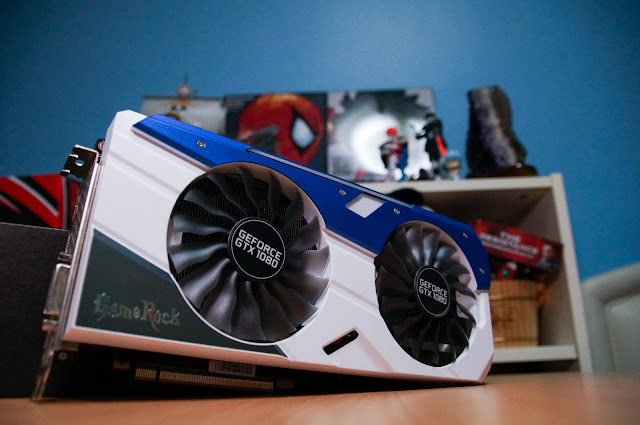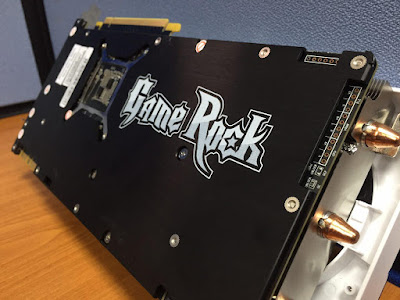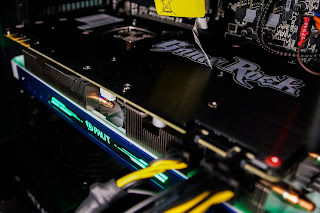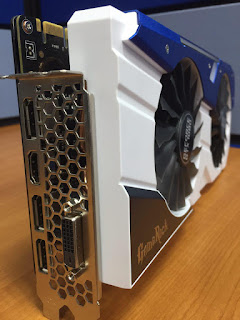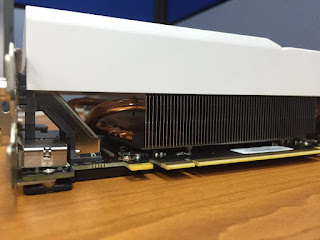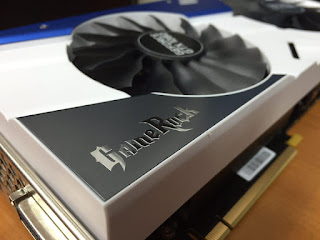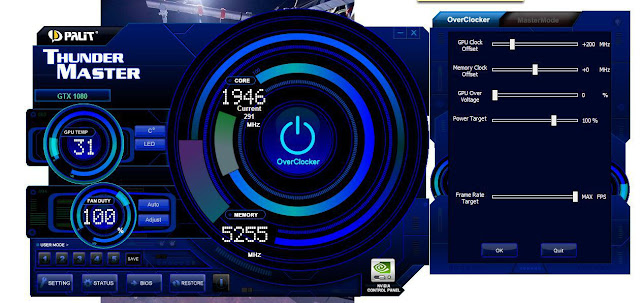Introduction
Almost two months ago, NVIDIA announced their latest GTX 10 series consumer grade graphics card which generated much excitement with the PC gaming community due to its high performance and great price point. While it is said to be on sale in the world from the 27th May 2016, local stocks were only available in mid June. We have gotten our hands on the Palit flagship GTX 1080 for test today. The Palit GeForce GTX 1080 GameRock Premium Edition features a custom PCB, design and GPU cooling solution. In this article, we will discuss on the pros and cons of the card and also at the same time, run a few gaming benchmarks to determine if it is worth the price.
Specifically looking at the Palit GeForce GTX 1080 GameRock Premium Edition, we will cover the basic features of the card in terms of its specifications and improvements as compared to a reference card from NVIDIA. We will also look at the various design considerations put into the card by the engineers from Palit to create such a graphics power house. Of course, we will not leave our the performance tests which is the reason why many readers are here for.
About Palit and the new GameRock Series
Consumers should be familiar with Palit’s Jetstream series of premium graphics card. The Jetstream series was quite a popular model in the Singapore market due to its great design, added performance, and superb cooling capabilities. Moreover, with the highly competitive and attractive price point, Palit managed to sell off quite a number of Jetstream graphics card previously. Palit has refreshed their graphics card lineup with a new product series. The GameRock edition of graphics card now takes over the Jetstream series as the flagship model, specifically targeting gamers who desires extreme out of the box graphics performance. The GameRock edition brings the benefits of the Jetstream models to the next new level, while the Jetstream series remains to provide the best value to performance ratio in the market compared to competitors.
Specifications
As mentioned earlier, the GameRock edition lineup is tuned towards gamers. The Palit GeForce GTX 1080 GameRock Premium Edition differs from the NVIDIA reference card not only by design, but also the following technical specifications :
|
Specification
|
Reference NVIDIA GTX 1080 Founders
Edition |
Palit GeForce GTX 1080 GameRock Premium
Edition |
|
GPU Core Clock
|
1607MHz
|
1746MHz
|
|
Memory Clock
|
5000MHz
|
5250MHz
|
|
Slot Space Requirements
|
2
Slots |
2.5
Slots |
|
PCB Size
|
267mm
x 112mm |
285mm
x 133mm |
|
Power Draw
|
180w
(1 x 8 pin) |
200w
(1 x 8pin + 1 x 6pin) |
|
Palit Features
|
–
|
|
With such significant improvements, consumers can expect greater performance from this Palit offering. Moreover, due to the custom design of the card that is tuned for overclocking, advanced users can even push the card a little further to gain additional FPS for their games.
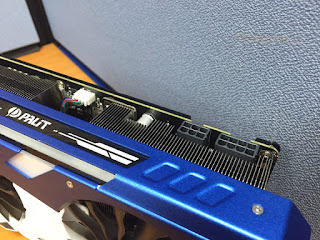 |
| 1 x 6 Pin + 1 x 8 Pin |
Design
Subsequently, we want to bring a point across that due to the custom design, this card is longer than usual graphics and may not fit into many mid tower sized cases in the market. In our test, we had a Cooler Master Storm Scout mid tower case which is considered a big mid tower case. We also had some problems installing the graphics card in due to the length of the card. To solve the problem, we had to remove the hard drive cage in order to fit the card in successfully. Consumers must definitely ensure that their PC case can fit the Palit GeForce GTX 1080 GameRock Premium Edition graphics card before making the purchase.
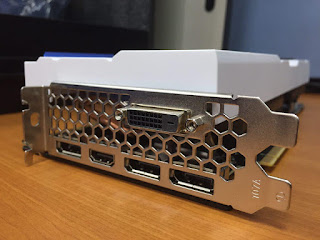 |
| 3 x DP, 1 x HDMI, 1 x DVI Ports |
Additionally, the heatsink fan and cooler takes up 2.5 slots. Such design may take up an PCI-E slot that could be better off used for another expansion card. Consumers must also determine the correct motherboard with the right PCI-E slot placement in order to put the Palit GeForce GTX 1080 GameRock Premium Edition graphics card in SLI mode. Other than the card being awkwardly larger than usual, we did not have any other complains.
Palit has decided to go with a white and blue colour combination for the shroud. Such a combination should fit well aesthically in most of the gaming PC setups. The shroud is made of a combination of plastic and metallic materials, possibly for better heat dissipation of the overall card. The card is also equipped with two massive fans that could bring the best possible airflow to the card with minimal noise. These two fans are attributed with how cool the Palit GeForce GTX 1080 GameRock Premium Edition graphics card runs. We were amazed by the temperatures on the card which opens up to a larger overclocking headroom. Furthermore, the graphics card is also equipped with a new honey comb ventilation hole design at the I/O port area. This allows the air to be channeled effectively out of the chassis, thus bringing the heat out of the case to the environment.
 Of course, we shall not forget about one of the main aesthetic highlight of the card. The Palit logo at the top of the card lights up in RGB colours and would definitely catch the eye of anyone who comes across it. The attention seeking feature would look great in any PC case that has a side window, or even better when two cards are placed together in the case in SLI mode. The RGB lighting can be controlled via the ThunderMaster Overclocking utility provided by Palit.
Of course, we shall not forget about one of the main aesthetic highlight of the card. The Palit logo at the top of the card lights up in RGB colours and would definitely catch the eye of anyone who comes across it. The attention seeking feature would look great in any PC case that has a side window, or even better when two cards are placed together in the case in SLI mode. The RGB lighting can be controlled via the ThunderMaster Overclocking utility provided by Palit.
Performance and Benchmark
|
Component
|
Specification
|
|
CPU
|
Intel
Core i5 4690 @ Stock Speed |
|
Motherboard
|
GIGABYTE
GA-Z87X-UD3H |
|
RAM
|
Kingston
DDR3 1600MHz 4 x 8GB = 32GB |
|
SSD
|
Samsung
840 2.5inch 240GB SSD (OS) |
|
HDD
|
Western
Digital Black 2TB (RAID 0) – Games Install |
|
Operating System
|
Windows
10 64 bit |
|
Chassis
|
Cooler
Master Storm Scout |
|
CPU Cooler
|
Cooler
Master Seidon 120V |
|
Graphics Card Model
|
Video Memory
|
Core Clock
|
Memory Clock
|
|
Palit GeForce GTX 1080 GameRock Premium Edition
|
8GB
GDDR5X |
1746MHz/1885MHz
|
10500MHz
|
|
Palit GeForce GTX 1080 GameRock Premium Edition graphics card
(OC) |
8GB
GDDR5X |
1946MHz
|
10500MHz
|
|
Zotac GeForce GTX 970
|
4GB
GDDR5 |
1076MHz
/ 1216MHz |
7010MHz
|
In our first two tests, we wanted to pitch the system in gaming oriented benchmarks. With 3DMark 11 (Performance Mode) and 3DMark Fire Strike, we would be able to determine how fast the card performs as compared to any other systems in the world.
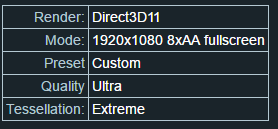 Next, we put our test setups on Heavens 4.0 benchmarks which utilizes various NVIDIA technology for rendering. We can compare specifically how much improvements was made between the two generations of NVIDIA graphics card and between architectural differences. Even though the GTX 970 is not the top of the line card for its series, it should still be able to provide a good gauge in the improvements.
Next, we put our test setups on Heavens 4.0 benchmarks which utilizes various NVIDIA technology for rendering. We can compare specifically how much improvements was made between the two generations of NVIDIA graphics card and between architectural differences. Even though the GTX 970 is not the top of the line card for its series, it should still be able to provide a good gauge in the improvements.
Lastly, we have various game benchmarks that utilizes different Direct X versions. We can determine how much FPS and performance we can get from various games with these cards. Games run at 1080p resolution with all settings maxed out. AA and AS set to maximum.
Comparing between the GTX 1080 and GTX 970, we can see improved performance across the board. In average, there was about 20% increase in terms of performance on the stock Palit GeForce GTX 1080 GameRock Premium edition than the GTX 970 with games. Unigine Heavens 4.0 benchmark saw the biggest gap between the two cards, as GTX 1080 is recorded to be more than twice as fast as the GTX 970. This has certainly indicated that the new card is able to handle the different DX11 features much better than its predecessors.
However, as the GTX 970 is still performing very well for the games in our benchmarks, we feel that an upgrade is not definitely necessary games when running at 1080p Full HD resolution. The performance gains on the GTX 1080 would be significant if gamers were to run their games at 4K and above resolutions, and we would recommended the upgrade as the set up will benefit from an increased video memory and higher graphical processing capabilities.
Conclusion
For the LATEST tech updates,
FOLLOW us on our Twitter
LIKE us on our FaceBook
SUBSCRIBE to us on our YouTube Channel!


